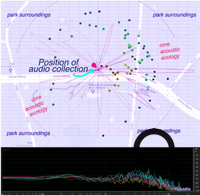
CONTRIBUTORS
José Manuel Flores
Dr. Lucía Durá
AFFILIATIONS
The University of Texas
at El Paso
EMAILS:
Soundscapes Analysis
6
For a more in-depth analysis, we took our Soundscapes to an experimental plane. We gradually combined analysis tools from Adobe Audition and Google maps to reference the distance of influence in one acoustic ecology. The resulting graphics of the Phase Analysis tool are juxtaposed in with the Google maps and manipulated using Adobe Photoshop.
Audio 21. Field recordings “Chanates.” Source: Border Soundscapes Project (2019)
Audio 21 contains a field recording made in the area of El Chamizal in Ciudad Juárez. El Chamizal is a binational park formed after a border dispute in 1964. The soundscape spectral display is shown in Figure 6. In the foreground the song of some birds is heard, called “Chanates” or Quiscalus mexicanus by the people, and known in English as the great-tailed grackle. Its singing is so prominent that it practically mutes any other sound influence. This acoustic ecology has a boom schedule that begins during the spring season.
Figure 6. Field recordings “Harmonic Figures.” Source: Border Soundscapes Project (2019)
To investigate the song of the birds, we analyzed the spectral frequency of this soundscape. This tool gave us is a way to visualize where the sound energy is in the entire audio spectrum. Through the enhancement of the image and after selecting a fragment of the song of these birds, it is possible to visualize a key in D Major accompanied by a first harmonic in an octave and the second harmonic in A fifth (refer to Figure 6).
Figure 7. Field recordings “Mapping Ecologies.” Source: Border Soundscapes Project (2019)
Figure 7 shows a cartographic representation of the exact location in which the sound of these birds were collected. The acoustic ecology of El Chamizal is an urban park of approximately 1.2 km. These birds rest in the trees and their song manages to expand several meters around the area. With the available technological resources, it is somewhat difficult to know exactly the extension of the emission of its sound. In an attempt to trace this sound phenomenon, we carried out the sound analysis carried out through Adobe Audition software and the juxtaposition between Google Maps and Adobe Photoshop.

Figure 8. Field recordings “Phase wheel analysis.” Source: Border Soundscapes Project (2019)
The Phase Analysis tool within Adobe Audition gives us different modalities to visualize the sound (refer to Figure 8). The specific tool we used was Phase Wheel. Graphically, it shows the extension of sound in small circles of colors. The digital samples can be modified depending on the samples, this first graph shows a sample of 512 and is modified until reaching the numerical data of 16384 samples.
Figure 9. Field recordings “Mapping acoustic ecology 16384 samples.” Source: Border Soundscapes Project (2019)
Figure 9 shows that the more we increase the number of samples, the greater the visual result in colored points. Basically, this analysis tool allows the audio designer to perform a measurement of the stereo waves and envelopes, to identify errors in the sound or unwanted noise. However, for this exercise the tool allows us to have a visual idea about the expansive form of sound. This, together with a map of the area, gives us an approximate idea about the sound development of the border Chanate.
In addition to visualizing the birdsong sound energy, the tools shown open up a field of possibilities to improve our ear culture but also to have an accurate notion about the musical structure of the things we hear, in this case, the great-tailed grackle. Everything we hear emits tones that can be perceived through technology such as Adobe Audition to improving our ear culture, which opens up interdisciplinary connections. The dialogism between rhetoric and musical theory may lead us to carry out grounded analyses on the influence of sounds on humans and, in turn, to awake a dialogue with other disciplines to listen to other fields of knowledge. The fantastic singing of these birds is pretty frequent in the Paso del Norte region; the ontological experience overflows notions in those who enjoy its song, and those who do not. Despite having different "listening" perspectives, e.g., some might not enjoy the sounds of birds, the prevalence of reflections, analyses, and compositions about birdsongs (in literature, film, and commercial soundscapes) points to birds as masterful musicians.
The Border Soundscapes Project







